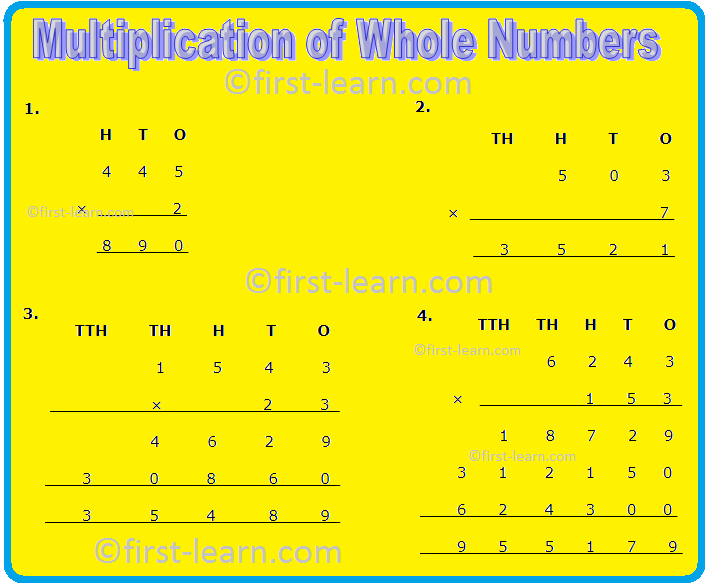Multiplication of Whole Numbers
Whole numbers are positive integers starting from zero and continues till infinity. We have already discussed with addition and subtraction of whole numbers. Now, we are here to discuss another basic operation with whole numbers that is multiplication of whole numbers.
Suppose let’s take an example:
1. 2 × 5 = 10
Again, 2+2+2+2+2 =10
2. 3 × 6 =18
3+3+3+3+3+3 = 18
What can be concluded from this?
Multiplication is nothing but actually repeated addition. When we are dealing with large numbers then repeated addition becoming time consuming, tiring and confusing as well. Hence we opt for multiplication as it becomes much easy than repeated addition.
Here are now few examples of multiplication of whole numbers
1.
H T O
4 4 5
× 2
8 9 0
The number in the first row that is 445 is called the multiplicand and 2 is called the multiplier. Now 2 is multiplied each time starting from the right side or ones place by every number. 2 is first multiplied with 5 to get 10. But we cannot write 10 hence we are writing 0 and 1 is carryover. Then again in the tens place 2 is multiplied with 4 to get 8 plus 1 carryover from the ones place so it becomes 9. Lastly 2 is again multiplied with 4 to get 8 and there is no carryover. The answer obtained that is 890 is called the product.
2.
TH H T O
5 0 3
× 7
3 5 2 1
Here 503 is the multiplicand and 7 is the multiplier and 3521 is the product. In the same way 7 is multiplied with 3 to get 21. We cannot write 21 so we are writing 1 and 2 carryover. Then again 7 is multiplied with 0 to get 0 plus 2 carryover. Lastly 7 is multiplied with 5 to get 35 and no carryover.
3.
TTH TH H T O
1 5 4 3
× 2 3
4 6 2 9
3 0 8 6 0
3 5 4 8 9
1543 is the multiplicand and 23 is the multiplier. Now in the same way as discussed above 1543 is the multiplicand is multiplied with the multiplier 3 to get 4269. Again, 1543 the multiplicand is multiplied with the multiplier 2 to get 3086. Lastly both 4629 and 30860 is added to get the final product 35489
4.
TTH TH H T O
6 2 4 3
× 1 5 3
1 8 7 2 9
3 1 2 1 5 0
6 2 4 3 0 0
9 5 5 1 7 9
6243 is the multiplicand and 153 is the multiplier. Now in the same way as discussed above 6243 is the multiplicand is multiplied with the multiplier 3 to get 18729. Again, 6243 the multiplicand is multiplied with the multiplier 5 to get 31215. 6243 is multiplied with 1 to get 6243. Lastly all the three are added to get 955179.
From Multiplication of Whole Numbers to HOME PAGE
Recent Articles
-
What Is Plasma? | Blood Plasma | Proteins | Nutrients | Cholesterol
Nov 07, 25 10:29 AM
Blood is a mobile fluid which is a connective tissue and is derived from the mesoderm like cell any other connective tissue. Colour of blood is reddish and that flows inside the blood vessels by means… -
Disorders of Respiratory System | Tuberculosis | Pleurisy | Emphysema
Oct 28, 25 11:39 PM
Tuberculosis is very common disease and is caused by a type of bacteria called Mycobacterium tuberculosis. This disease causes different trouble in the respiration and infection of several parts of th… -
Regulation of Respiration | Respiratory Centres | Inspiratory Area |
Oct 14, 25 12:13 AM
Respiratory Centre is the area that controls the rate of respiration and it is observed to be located in medulla oblongata and pons. Respiratory Centre has the following will dispersed components like… -
Explain Transport of Gases | External Respiration | Tissue Respiration
Oct 09, 25 11:35 PM
In humans gaseous exchange is completed in the following ways the steps are - External Respiration or Breathing - Breathing in false taking in of Oxygen and giving out of carbon dioxide in the body. M… -
Kind and Number of Teeth | Location of Teeth in Mouth | Care of Teeth
Sep 11, 25 12:52 AM
Kind and Number of Teeth






New! Comments
Have your say about what you just read! Leave me a comment in the box below.